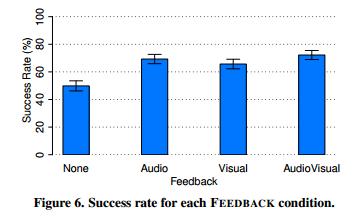Summary
Tests were created by writing custom software that allowed users to "learn" how to tap rhythmically using three methods: audio, visual, or both. The program would picture an expected form of input in the form of bars with two widths. The thin width would indicate a rest moment while the thick line would indicate that the user needs to tap. The longer this thicker width is, the longer the tap needs to be held.
 |
| Diagram of taps as presented in the test app |
One facet that the researchers considered important was the fact that the average user without any musical knowledge should be able to make use of this tapping as a form of input. Because of this, many of the subjects they gathered had no previous musical training or concept of tempo, beats, and how taps relate to both. These were concepts that the test app attempted to teach.
To help teach these concepts, three methods were employed. One method consisted simply of teaching via sound cues, the other attempted to teach and ask for input via visual cues, with the rhythm diagrams changing color from left to right in synchronization with the tempo. The third consisted of both at the same time. Accuracy of the taps correctly inputted with the tempo was measured as quantitative data.
Related Works
The works related to using tapping for input in electronics were were found to be the following papers:
- TapSongs: Tapping Rhythm-Based Passwords on a Single Binary Sensor
- Tok!: A Collaborative Acoustic Instrument using Mobile Phones
- RhythmLink: Securely Pairing I/O-Constrained Devices by Tapping
- Polyrhythm Hero: A multimodal polyrhythm training game for mobile phones
- Evaluation of a rhythm based user authentication system for mobile devices
- Exploiting rhythmic sense in a ringtone composer
- Finger tapping measurement system design on mobile devices
- Tap input as an embedded interaction method for mobile devices
- Gestures all around us: user differences in social acceptability perceptions of gesture based interfaces
- Instrumented Usability Analysis for Mobile Devices
The main piece of information I extracted from these related works is that rhythmic tapping as a form of input device has been explored and researched extensively, being used in a variety of applications, many of which are already slated to be in use soon. The cell phone company Research In Motion, for instance, has considered using rhythmic tapping as a form of password. Another paper asserted tapping as a useful tool for learning rhythms through phone apps. Another found that one can create custom unique ringtones using rhythmic tapping to let the user know that it is his or her phone that is ringing via this method of input. Essentially, this is a technology that has essentially advanced enough to make it to the mainstream consumer space.
Evaluation
Quantitatively, the results of the success rate were around 64.3% percent, which the paper makes a point to emphasize that the program used for the testing was especially strict in what it considered a tap in the expected tempo. They noted that the lengths of the taps and beats themselves created an essential difficulty for the user, with particular combinations having the user be more prone to error than others.
 |
| Graph detailing success rate depending on different tap and beat tempos |
In addition, the test measured the success rate depending on the type of condition that was used on the test itself, varying between visual, audio, both or neither. It was qualitatively concluded that having users input the taps that were given by themselves with no additional help from the test app resulted in the worst success rates, while Audio and AudioVisual tended to be the most successful ones.
Qualitatively, the researchers asked the subjects their opinion on certain aspects of the exam. Of note was the fact that they personally expressed belief that the AudioVisual condition tended to be the most confusing for them, as they saw that it was overwhelming to focus on both at once. Additionally, they tended to prefer the audio feedback.
From both these types of data, the researchers concluded that there's significant potential in the use of rhythmic tapping among people who are not musically trained for it. They conclude that this makes certain things possible like teaching people Morse code and using tapping to communicate with it, as well as using certain rhythms to make inputs to the cell phone without actually looking at it.
Discussion
Overall, I found this paper to be interesting because it let me realize that there was another facet of touch-based input that I had not previously thought about. I think something like this can successfully curb dangerous situations such as texting while driving if users are provided the choice to be able to communicate via tapping without having to look down on the phone at all.
Understandably, making rhythmic taps be read by software isn't particularly complicated, but what this paper explores is the possibility that an app might be able to teach new users how to tap reliably. With a 64% rate of success in terms of exact matches with tempo and taps inputted, this shows that the method presented can be successful in introducing a new dimension in phone input.

No comments:
Post a Comment